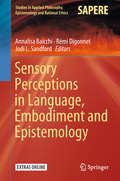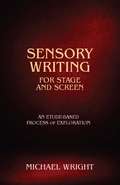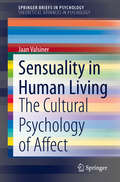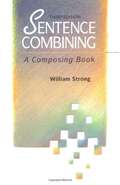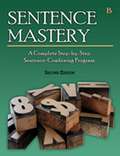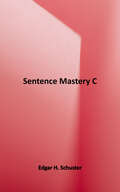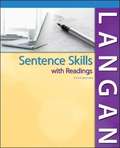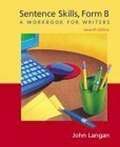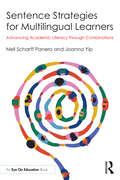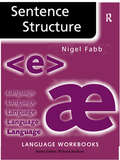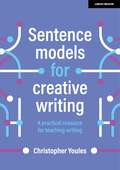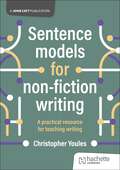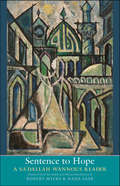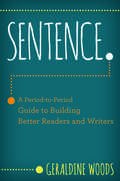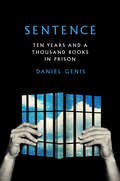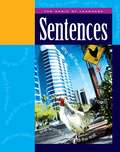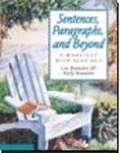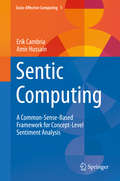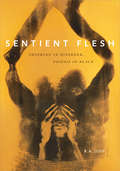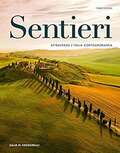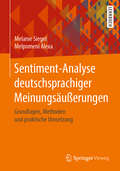- Table View
- List View
Sensory Perceptions in Language, Embodiment and Epistemology (Studies in Applied Philosophy, Epistemology and Rational Ethics #42)
by Annalisa Baicchi Rémi Digonnet Jodi L. SandfordThe book illustrates how the human ability to adapt to the environment and interact with it can explain our linguistic representation of the world as constrained by our bodies and sensory perception. The different chapters discuss philosophical, scientific, and linguistic perspectives on embodiment and body perception, highlighting the core mechanisms humans employ to acquire knowledge of reality. These processes are based on sensory experience and interaction through communication.
Sensory Writing for Stage and Screen: An Etude-Based Process of Exploration
by Michael WrightThrough a series of systematic explorations across a wide range of scenarios, Sensory Writing for Stage and Screen offers script writers exercises for attending to their own sensory experiences as a means to exploring the sensory experiences—and worlds—of the characters they create.
Sensuality in Human Living: The Cultural Psychology of Affect (SpringerBriefs in Psychology)
by Jaan ValsinerThis book is a theoretical account for general psychology of how human beings meaningfully relate with their bodies-- from the basic physiological processes upwards to the highest psychological functions of religiosity, ethical reasoning, and devotional practices. It unites art and science into a new theory of affective synthesis that human minds are constantly involved in their everyday life worlds. Provides a new theory of aesthetic synthesis;Demonstrates the links between art and science;Provides a new understanding of the role of affect in human cognition.
Sentence Combining: A Composing Book
by William StrongThis highly regarded text helps developmental writing students strengthen their writing skills and understand some of the stylistic choices available to them in written English. Simply put, sentence combining involves putting short, choppy sentences together to make more interesting, readable ones. In the process, students learn the importance of sentence variety in improving syntax. Students are able to explore a variety of ways to say something in writing and learn that there is not a single "right" way to express their point. SENTENCE COMBINING features an accessible and humorous writing style, along with innovative and thoroughly tested exercises which not only allow students to flex their creative muscles, but also offer them insights into current topics and issues. New to this edition are two end-of-text appendices on sentence combining, the writing process and sentence and paragraph strategies.
Sentence Composing For College: A Worktext On Sentence Variety And Maturity (Sentence Composing)
by Don KillgallonWith the original publication of his sentence composing series, Don Killgallon changed the way thousands of high school English teachers and their students look at language, literature, and writing by focusing on the sentence. In this expanded series, Killgallon presents the same proven methodology but offers all-new writing exercises for middle school, high school, and college students. <p><p> Unlike traditional grammar books that emphasize sentence analysis, these worktexts asks students to imitate the sentence styles of professional writers, making the sentence composing process enjoyable and challenging. Killgallon teaches subliminally, nontechnically - the ways real writers compose their sentences, the ways students subsequently intuit within their own writing. <p> Designed to produce sentence maturity and variety, the worktexts offer extensive practice in four sentence-manipulating techniques: sentence unscrambling, sentence imitating, sentence combining, and sentence expanding. It's demonstrably true that Sentence Composing can work anywhere--in any school, with any student.
Sentence Comprehension as a Cognitive Process: A Computational Approach
by Shravan Vasishth Felix EngelmannSentence comprehension - the way we process and understand spoken and written language - is a central and important area of research within psycholinguistics. This book explores the contribution of computational linguistics to the field, showing how computational models of sentence processing can help scientists in their investigation of human cognitive processes. It presents the leading computational model of retrieval processes in sentence processing, the Lewis and Vasishth cue-based retrieval mode, and develops a principled methodology for parameter estimation and model comparison/evaluation using benchmark data, to enable researchers to test their own models of retrieval against the present model. It also provides readers with an overview of the last 20 years of research on the topic of retrieval processes in sentence comprehension, along with source code that allows researchers to extend the model and carry out new research. Comprehensive in its scope, this book is essential reading for researchers in cognitive science.
Sentence Mastery - Book B
by Edgar H. SchusterA Sentence-Combining Program Integrated with Practice in Basic Grammar, Usage, and Mechanics
Sentence Mastery - Book C, Second Edition
by Edgar H. SchusterThis book is for you. Its purpose is to help make you a better writer. It is based on an old idea--that one can improve a skill by practice. You know that batters improve by practicing hitting. Piano players improve by practicing the piano. Carpenters improve by practicing their trade. There is every reason to believe that you will improve as a writer by writing. Yet it is not certain that you will improve only by writing. Student writers who do not know certain fundamentals may merely repeat their errors. This book offers carefully controlled practice. If you can understand a few basic clues, you will not merely write sentences, you will write good sentences. By the time you have finished this book, you will have written hundreds of good sentences. You will be well on your way toward sentence mastery. In addition to writing good sentences, you will also gain practice in writing correct forms of words. For example, you will practice writing write and right, past and passed, to mention only two of the twenty items in this book. In the first problem or two in early lessons, we call attention to these troublesome words by printing them in boldfaced italics. Boldfaced italics look like this: write, right; past, passed. In later lessons you will receive much additional practice writing such troublesome words. Some people naturally work faster than others. If you are one of these fast workers, you will find extra practice for each lesson at the back of the book, beginning on page 129. If you finish any lesson before your classmates, turn to the proper page near the end of the book and you will find more sentences to do. This book may also help you to improve your punctuation, capitalization, spelling, and even your handwriting.
Sentence Skills with Readings (Fifth Edition)
by Paul Langan John LanganGrounded in John Langan’s Four Bases – unity, coherence, sentence skills, and support – Sentence Skills with Readings employs a unique personalized learning plan to address student deficits in grammar and mechanics and to free instructional time for activities emphasizing writing process and critical thinking. Sentence Skills with Readings offers students a practical guide to becoming better writers. This best-selling sentence-level text returns in a new edition highlighting the essential grammar, mechanics, punctuation, and usage skills needed for clear, college-level writing.
Sentence Skills: A Workbook for Writers, Form B
by John LanganThis best-selling sentence-level worktext by John Langan continues to help students master the essential grammar, mechanics, punctuation, and usage skills needed for clear, thoughtful writing. The seventh edition of Sentence Skills, Form B features a greater emphasis on prewriting and revision, a new chapter for non-native speakers, and much more!.
Sentence Strategies for Multilingual Learners: Advancing Academic Literacy through Combinations
by Nell Scharff Panero Joanna YipThis book presents Combinations as a set of high-yield instructional strategies for advancing academic literacy for multilingual learners and all students. It discusses the strategies themselves as well as how they work to advance content and language learning simultaneously, across the grades and content areas. The book is particularly beneficial for all teachers working with linguistically and culturally diverse learners to accelerate their language and content learning. Utilizing these strategies will not only greatly improve students’ writing but also supports their critical thinking, content area reading and language comprehension skills. This book argues for utilizing Combinations with Strategic Inquiry, presenting evidence of how each amplifies the impact of the other, and how together they address many of the challenges to learning new and counter-cultural methods and to establishing school and district cultures in support of multilingual learners’ success. This book is a great resource for classroom teachers, literacy coaches and school and district administrators who want to support multilingual learners and all students to thrive.
Sentence Strategies for Multilingual Learners: Advancing Academic Literacy through Combinations
by Nell Scharff Panero Joanna YipThis book presents Combinations as a set of high-yield instructional strategies for advancing academic literacy for multilingual learners and all students. It discusses the strategies themselves as well as how they work to advance content and language learning simultaneously, across the grades and content areas.The book is particularly beneficial for all teachers working with linguistically and culturally diverse learners to accelerate their language and content learning. Utilizing these strategies will not only greatly improve students’ writing but also supports their critical thinking, content area reading and language comprehension skills. This book argues for utilizing Combinations with Strategic Inquiry, presenting evidence of how each amplifies the impact of the other, and how together they address many of the challenges to learning new and counter-cultural methods and to establishing school and district cultures in support of multilingual learners’ success.This book is a great resource for classroom teachers, literacy coaches and school and district administrators who want to support multilingual learners and all students to thrive.
Sentence Structure (Language Workbooks)
by Nigel FabbSentence Structure: introduces the evidence for sentence structure and reveals its purpose is based on a problem-solving approach to language teaches the reader how to identify word classes, such as noun, preposition and demonstrative uses simple tree structures to analyse sentences contains numerous exercises to encourage practical skills of sentence analysis includes a database and exercises that compare the structure of English with other languages. The second edition of Sentence Structure has been revised and updated throughout and includes new material on tense, aspect, modality and the verb phrase, whilst the order of topics has been rearranged to improve clarity.
Sentence models for creative writing: A practical resource for teaching writing
by Christopher YoulesTeaching at sentence level is essential to improve writing. Knowing this, I desperately searched for a book packed full of sentence models that I could use to inspire my students. On discovering that no such book existed, I spent the next year poring over hundreds and hundreds of books to tap into the magic formula of what makes a great sentence. I sorted all these fantastic sentence structures into the domains through which we write stories: action, setting, character, feelings, physical effects, thoughts, the senses, and dialogue. This book contains hundreds of those sentence models. Each chapter also contains practical advice on effectively teaching the different aspects of story writing. The sentences can be used as creative writing exercises, inspiration for your exemplary text, or ideas for writing lessons. This book will reveal the magic formula behind great writing and give you a secret window into how this writing is created.
Sentence models for non-fiction writing
by Christopher YoulesAre your students struggling to write clear, concise, and engaging non-fiction prose? Offering a wealth of sentence models and advice, this practical book provides everything you need to help students of all ages to craft compelling sentences and learn the essential elements of effective non-fiction writing.The comprehensive coverage includes: selecting engaging topics for non-fiction writing; planning a structure; and tailoring the style to the audience. Improve your students' clarity and coherence and enable them to master the art of writing in different non-fiction genres, including informative writing and persuasive writing.
Sentence models for non-fiction writing
by Christopher YoulesAre your students struggling to write clear, concise, and engaging non-fiction prose? Offering a wealth of sentence models and advice, this practical book provides everything you need to help students of all ages to craft compelling sentences and learn the essential elements of effective non-fiction writing.The comprehensive coverage includes: selecting engaging topics for non-fiction writing; planning a structure; and tailoring the style to the audience. Improve your students' clarity and coherence and enable them to master the art of writing in different non-fiction genres, including informative writing and persuasive writing.
Sentence to Hope: A Sa'dallah Wannous Reader (The Margellos World Republic of Letters)
by Sa'dallah WannousThe first major English‑language collection of plays and essays by Syrian playwright Sa'dallah Wannous Sa'dallah Wannous is acknowledged to be one of the Arab world’s most significant playwrights, writers, and intellectuals of the twentieth century. This is the first major English‑language collection that brings together his most significant plays and essays. Selections include the groundbreaking 1969 play An Evening’s Entertainment for the Fifth of June, a scathing indictment of the duplicity of Arab leaders during the 1967 War, as well as Wannous’s most celebrated play, Rituals of Signs and Transformations, a bold treatment of homosexuality, prostitution, clerical corruption, and the quest for female liberation. In addition to his work as a playwright, Wannous, like Brecht, was an astute theatrical and cultural critic, and his essays, some of which are included here, offer shrewd diagnoses of the ills of Arab society and the essential role of theater in ameliorating them.
Sentence.: A Period To Period Guide To Building Better Readers And Writers
by Geraldine WoodsSometimes it’s better to start small, with a sentence. Every English teacher has experienced it: students staring at an empty page, seemingly paralyzed by a writing assignment. When this happens, it may be time to back off from the Big Idea approach to the art of reading and writing, and zero in on a single sentence. In this book, a master teacher offers a complete guide to a sentence-level approach. Helping students recognize the techniques that make sentences great is the first step, and there are plenty of examples here from YA novels, TV shows, and song lyrics as well as the novels, poetry, and nonfiction pieces that form the canon of middle and high school reading lists. Lesson plans include activities to introduce the featured element of style; questions to guide students in their analysis; and writing prompts and activities to spark students’ interest and creativity. With this Little-to-Big strategy, students move quickly from analysis of the words between two periods to the universe of ideas of which that sentence is a part. They may even be eager to write their own
Sentence: Ten Years and a Thousand Books in Prison
by Daniel GenisA memoir of a decade in prison by a well-educated young addict known as the "Apologetic Bandit"In 2003 Daniel Genis, the son of a famous Soviet émigré writer, broadcaster, and culture critic, was fresh out of NYU when he faced a serious heroin addiction that led him into debt and ultimately crime. After he was arrested for robbing people at knifepoint, he was nicknamed the &“apologetic bandit&” in the press, given his habit of expressing his regret to his victims as he took their cash. He was sentenced to twelve years—ten with good behavior, a decade he survived by reading 1,046 books, taking up weightlifting, having philosophical discussions with his fellow inmates, working at a series of prison jobs, and in general observing an existence for which nothing in his life had prepared him. Genis describes in unsparing and vivid detail the realities of daily life in the New York penal system. In his journey from Rikers Island and through a series of upstate institutions he encounters violence on an almost daily basis, while learning about the social strata of gangs, the &“court&” system that sets geographic boundaries in prison yards, how sex was obtained, the workings of the black market in drugs and more practical goods, the inventiveness required for everyday tasks such as cooking, and how debilitating solitary confinement actually is—all while trying to preserve his relationship with his recently married wife. Written with empathy and wit, Sentence is a strikingly powerful memoir of the brutalities of prison and how one man survived then, leaving its walls with this book inside him, &“one made of pain and fear and laughter and lots of other books.&”
Sentences (The Magic of Language)
by Ann HeinrichsSentences can be long and short, simple and complex. Regardless of what form they take, they are crucial to reading comprehension. Kid-friendly text and helpful exercises illustrate the different elements that comprise a sentence.
Sentences, Paragraphs, and Beyond: A Worktext with Readings
by Kelly Brandon Lee BrandonFrom the book: The text's three parts and the appendixes cover the full array of topics needed for developmental writing. Part One: Writing Sentences includes parts of sentence structure, phrases and clauses, kinds of sentences, sentence combining, sentence problems, pronoun use, modifiers, punctuation, and spelling. Part Two: Writing Paragraphs and Beyond covers the writing process with instructions, examples, demonstrations, and exercises in freewriting, brainstorming, clustering, topic sentence writing, outlining, revising, and editing. Part Three: Connecting Reading and Writing provides guidance in reading critically and writing summaries; practicing reading-related responses; and recognizing patterns such as process, cause and effect, and exemplification. Reading selections by students and professional writers are dually grouped by pattern and theme. Appendixes cover parts of speech, taking tests, writing a letter of application and a resume, and a guide for ESL students.
Sentic Computing
by Amir Hussain Erik CambriaIn this book common sense computing techniques are further developed and applied to bridge the semantic gap between word-level natural language data and the concept-level opinions conveyed by these. In particular, the ensemble application of graph mining and multi-dimensionality reduction techniques is exploited on two common sense knowledge bases to develop a novel intelligent engine for open-domain opinion mining and sentiment analysis. The proposed approach, termed sentic computing, performs a clause-level semantic analysis of text, which allows the inference of both the conceptual and emotional information associated with natural language opinions and, hence, a more efficient passage from (unstructured) textual information to (structured) machine-processable data.
Sentient Flesh: Thinking in Disorder, Poiesis in Black (Black Outdoors: Innovations in the Poetics of Study)
by R. A. JudyIn Sentient Flesh R. A. Judy takes up freedman Tom Windham’s 1937 remark “we should have our liberty 'cause . . . us is human flesh" as a point of departure for an extended meditation on questions of the human, epistemology, and the historical ways in which the black being is understood. Drawing on numerous fields, from literary theory and musicology, to political theory and phenomenology, as well as Greek and Arabic philosophy, Judy engages literary texts and performative practices such as music and dance that express knowledge and conceptions of humanity appositional to those grounding modern racialized capitalism. Operating as critiques of Western humanism, these practices and modes of being-in-the-world—which he theorizes as “thinking in disorder,” or “poiēsis in black”—foreground the irreducible concomitance of flesh, thinking, and personhood. As Judy demonstrates, recognizing this concomitance is central to finding a way past the destructive force of ontology that still holds us in thrall. Erudite and capacious, Sentient Flesh offers a major intervention in the black study of life.
Sentiment-Analyse deutschsprachiger Meinungsäußerungen: Grundlagen, Methoden und praktische Umsetzung
by Melanie Siegel Melpomeni AlexaDer Zugang zu Information ist durch das Internet erheblich verändert und erleichtert worden. Gleichzeitig gibt es seit dem Web 2.0 die Möglichkeit für alle Internet-Nutzer, selbst Inhalte beizusteuern, indem sie in Foren schreiben, oder Twitter, Xing, LinkedIn, Facebook oder andere soziale Medien nutzen und auf veröffentliche Posts z. B. durch Kommentare reagieren. Diese Fülle an Informationen und Meinungen ist ein wertvoller und in der Regel sehr großer Datenschatz, den man nur mit automatischen Verfahren sinnvoll nutzen kann.Die automatische Analyse von Meinungsäußerungen gehört in die Anwendungsbereiche Informationsextraktion und Inhaltsanalyse sowie Text Mining. Aus Texten von Internet-Nutzern werden Informationen extrahiert und analysiert, wie sie sich zu bestimmten Themen, Produkten oder Ereignissen äußern.Dieses Buch gibt eine systematische Einführung in Methoden der automatischen Analyse von Meinungsäußerungen und zeigt die Anwendung der beschriebenen Methoden in Programmierübungen. Der Fokus liegt dabei auf deutschsprachige Daten, also auf linguistischen Ressourcen sowie Methoden zur automatischen Analyse für die deutsche Sprache. Viele Übungsaufgaben sowie in Python implementierte Programmierbeispiele und -aufgaben machen das Buch zum optimalen Begleiter für Studium und Selbststudium.
